Cassette Players with USB: Features and Benefits
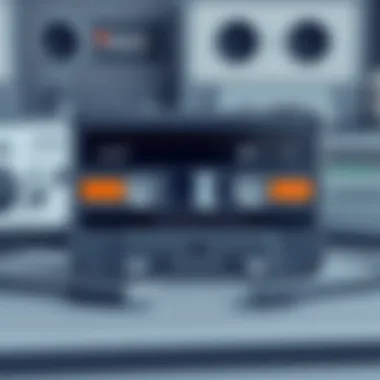
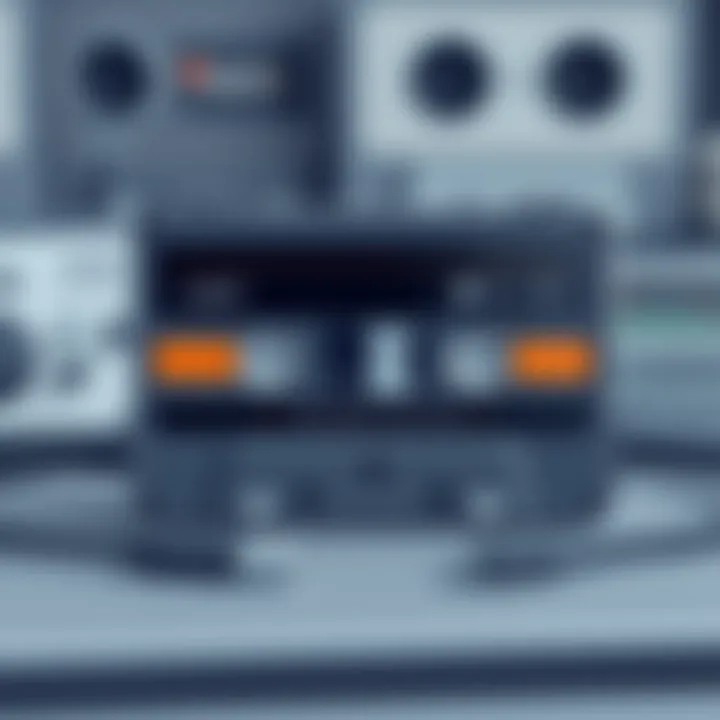
Intro
The resurgence of cassette players in the digital age might seem like a quirk of nostalgia, but it's more than just a passing trend. With the integration of USB connectivity, these devices create a bridge between the familiar analog world and the ever-evolving digital landscape. This guide aims to delve into the features, advantages, and the occasional drawbacks of cassette players designed with USB functionality. Whether it's about transferring cherished mixtapes to digital formats or simply enjoying a classic listening experience, understanding where these devices stand in today’s tech market is essential.
Nostalgia isn't just about fuzzy memories. It's about the tactile experience of handling cassette tapes, the unique sound qualities, and the comfort that comes with the crackle of a tape. But with the twist of a USB port, these old-school players are being reevaluated and appreciated for the contemporary conveniences they provide.
Let’s take a closer look at how these cassette players operate, the tangible specifications that set them apart, and their increasing popularity among a diverse audience, including tech enthusiasts, casual listeners, and gamers alike.
Understanding Cassette Players
Cassette players might seem like relics from another era, yet they hold a unique charm that captivates both nostalgia seekers and tech enthusiasts alike. In the current landscape, where digital reigns supreme, exploring the relevance of these devices sheds light on broader themes including the blend of technology with human experience, and how we engage with music and audio.
When discussing cassette players, it's important to understand not just their mechanics, but the cultural history they carry. These devices aren’t merely hardware; they are vessels of memories, encapsulating a time when music was tactile. In an age dominated by streaming services and digital downloads, the resurgence of cassette players signals a desire for authenticity. They invite users to engage with their music collection in a tactile manner, making listening an experience rather than a background task.
Do we find solace in the textured warmth of tapes and the subtle imperfections they bring? Or is it the thrill of discovery, rummaging through old tapes in a dusty box, that brings joy? Understanding cassette players offers insights not just into the technology itself, but also into our complex relationship with music.
Historical Context
The history of cassette players stretches back to the late 1960s, during a time when the audio landscape was swiftly evolving. Originally manufactured for dictation purposes, these compact devices gained popularity for music playback by the 1970s. Artists began to embrace the format, leading to its proliferation in households around the world. Notably, the introduction of the Sony Walkman in 1979 revolutionized how people enjoyed music on-the-go; suddenly, music was portable. This era laid the foundation for the cassette’s enduring status as a cultural icon.
Analog vs Digital Formats
When juxtaposing analog and digital formats, one sees a distinct divide yet an intriguing symmetry. Analog cassettes provide a warm sound, often described as richer, with a certain nostalgic quality. For many, the imperfections — a bit of tape hiss, slight fluctuations in pitch — contribute positively to the listening experience, creating a deeper emotional connection. Conversely, digital formats deliver clarity and precision. Yet, as consumers gravitate towards flawless audio streams, some lament the loss of character that comes with digital perfection.
This ongoing battle between analog warmth and digital precision highlights consumer choice and experience in the modern audio market. With cassette players integrating USB connectivity, they blend both worlds: maintaining the authenticity of analog while adapting to digital conveniences.
How Cassette Players Work
Understanding the mechanics of cassette players can be largely enlightening. At their core, these devices translate physical vibrations into electrical signals. When a cassette tape is played, a magnetic head reads the tape's magnetic patterns. These patterns mirror sound waves recorded when the tape was created. As the tape moves past the head, it creates electrical signals, which are amplified to reproduce the original sound.
Most cassette players feature buttons for play, pause, rewind, and fast-forward. However, those equipped with USB connectivity offer new functionalities like converting cassette recordings into digital formats. This feature alone highlights the evolving nature of technology, bridging past experiences with modern-day conveniences.
"In every cassette player lies a story, waiting to be told, one tape at a time."
The Emergence of USB Technology
The exploration of cassette players with USB connectivity opens up a fascinating discussion about the evolution of audio technology. When we look at the rise of USB—or Universal Serial Bus—it's crucial to understand its role not just in general devices, but as a game changer in the audio landscape. Traditional cassette players, while possessing a charming nostalgia, faced limitations that USB technology aims to address.
Foreword to USB Interfaces
USB technology has transformed the way we connect devices, making it easier for users to interface various audio systems. Introduced in the mid-1990s, USB interfaces provided a standardized connection for devices that once required unique cords or ports. For cassette players, this means a seamless way to link with computers, smartphones, and other modern gadgets.
Through USB, users can facilitate quick data transfer and simplified installation without needing complex configurations. Instead of juggling different connectors or facing compatibility issues, USB creates a streamlined experience.
Benefits of USB Integration in Audio Devices
The advantages of incorporating USB technology into cassette players extend beyond just connection ease. Here are a few notable benefits:
- Versatility: USB-compatible cassette players can function as traditional players while also allowing digital playback from various devices. The dual-functionality caters to diverse consumer preferences.
- Enhanced Sound Quality: Modern USB equipped devices often incorporate improved DAC (Digital-to-Analog Converter) systems, leading to superior audio fidelity compared to older cassette models.
- Portability Features: With USB, many cassette players become portable powerhouses. Users can easily plug into power banks or laptops, making them less reliant on batteries.
This integration revives the nostalgic sound of cassettes while enhancing their usability in today’s tech-driven landscape.
Comparative Analysis with Traditional Cassette Players
Analyzing USB-enabled cassette players against traditional models reveals significant disparities that reflect consumer needs and technological advancements.
- Functionality: Traditional cassette players often restrict playback to cassette tapes only. In contrast, USB-capable models can handle multiple formats, adding versatility.
- User Experience: Older cassette players sometimes face mechanical issues and are prone to wear. Modern USB players utilize electronic parts, reducing maintenance and enhancing durability. Users appreciate less fuss when enjoying their tunes.
- Storage and Recording: Standard players lack integrated recording features. USB-enabled devices not only allow users to record audio directly but also save those recordings in popular formats like MP3. This bridging between past and present offers a compelling reason for consumers to engage with these devices.
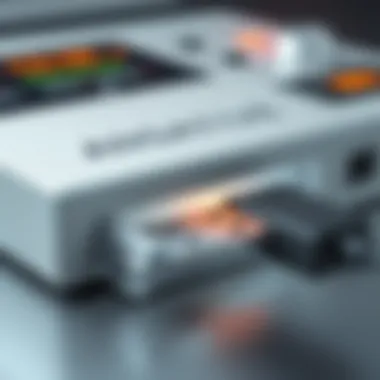
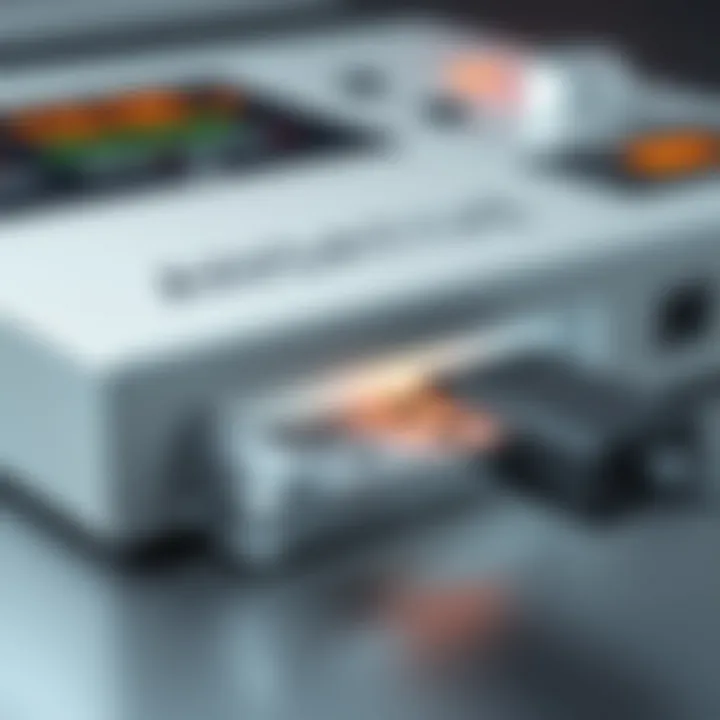
"The integration of USB technology into cassette players not only repackages a classic but breathes new life into it, engaging both the nostalgic listener and the modern music lover."
In summary, the emergence of USB technology in cassette players signifies a pivotal moment in the audio market, seamlessly blending nostalgia with modern functionality. As music evolves, so does the way we interact with it, and USB connectivity plays a key role in this transformative journey.
Features of Cassette Players with USB
Understanding the features of cassette players equipped with USB connectivity is of utmost significance in a rapidly changing audio landscape. As these devices blend nostalgic elements with modern technological perks, they complicate our relationship with music. Each feature offers a glimpse into how they can enrich our listening experience while accommodating contemporary needs.
Playback Capabilities
One of the foremost advantages of cassette players with USB is their playback capabilities. Unlike traditional cassette players that strictly play tapes, the modern variants often support a wider range of audio formats. This means that users can enjoy music from CDs, MP3 files, and even streaming services when paired with the right devices. The transition from analog to digital format, while still retaining the warmth of that classic cassette sound, is an appealing concept for many.
For instance, when you pop a cassette into one of these players, you're not just listening to bygone tunes. You might also be enjoying remastered tracks that come alive through enhanced audio technology. Even the way these players handle the sound output has evolved, integrating better sound isolation features to prevent unwanted noise from creeping into the listening experience.
Recording Functionality
Recording functionality sets apart the USB-connected cassette players from their older counterparts. While traditional players often limited users to playing existing tapes, modern versions allow for the recording of audio directly from a computer. This fresh capability adds a layer of versatility that resonates with audiophiles and casual listeners alike.
Imagine being able to convert your cherished vinyl or digital files into a cherished cassette format. This serves not only as a mode of preservation but also as an artistic expression for those who enjoy mixing different audio formats. The simplicity and convenience of this feature make it a sought-after aspect of USB cassette players.
File Format Compatibility
File format compatibility is another crucial element when discussing cassette players with USB connectivity. Many users are often unaware that cassette players are increasingly designed to handle various digital audio formats like WAV, MP3, and FLAC, among others. This adaptability makes them not just relics of a past era but also relevant players in today’s dynamic audio ecosystem.
Additionally, the ease with which users can convert these files into a format suited for cassette recordings speaks volumes about their versatility. It smooths the path for enthusiasts looking to maintain an archival collection while still enjoying the perks of modern playback.
"In a world where digital is king, blending the old with the new creates a unique sonic experience that resonates deeply with music lovers."
In summary, the features of cassette players equipped with USB ports present a refined approach to audio enjoyment. They allow users to engage in both nostalgic practices and modern functionalities, striking a fine balance between the past and the present.
Evaluating Performance Metrics
Evaluating performance metrics is crucial, especially when it comes to cassette players with USB connectivity. These devices, melding nostalgia with modern technology, can often lead to confusion among consumers interested in both retro charm and contemporary functionality. Performance metrics help clarify how well these players function in aspects like sound quality, durability, and user experience. Understanding these metrics allows buyers to make informed decisions, ensuring they choose products that meet their needs and expectations.
Sound Quality Assessments
When it comes to cassette players, sound quality is of prime importance. There are several aspects to consider in sound quality assessments:
- Frequency Response: This refers to the range of frequencies the player can reproduce. Ideally, you want a player that handles low bass and high treble well. A player with limited frequency response feels like trying to listen to a concert through a tin can—it's there, but you're missing out on the richness of the sound.
- Signal-to-Noise Ratio (SNR): This metric indicates the level of desired signal relative to the background noise. A player with a higher SNR ensures a clearer sound, making those mixtapes sound as crisp as when they were first recorded.
- Distortion Levels: It's vital to measure how much the audio quality is distorted during playback. Low distortion is key to maintaining the integrity of vintage tapes. An acceptable level is generally below 1%, as anything above that can become irritating and distracting.
By considering these criteria, users can identify cassette players capable of delivering satisfying and authentic audio experiences.
Durability and Build Quality
Durability and build quality are essential factors when evaluating cassette players. These devices, often subjected to travel and varied environments, must stand the test of time. Here are key considerations:
- Material Quality: Players made from sturdy materials tend to last longer. Players encased in metal or high-quality plastics usually resist wear and tear better compared to flimsy plastic counterparts.
- Component Selection: The internal components play a significant role in longevity. Look for devices with high-quality tape transport mechanisms and reliable connectivity ports. A poorly built internals can lead to frequent breakdowns, making your investment a short-lived affair.
- Weather Resistance: Some models offer a degree of weather resistance. While it's not feasible to use your cassette player in a rainstorm, those with protective design help resist everyday spills and humidity.
Taking these durability aspects into account helps ensure that your cassette player remains a reliable companion in your audio journey.
User Experiences and Reviews
User experiences and reviews provide real-world insights that technical specifications often overlook. Gathering feedback from diverse users allows potential buyers to grasp a clearer picture:
- Functional Reliability: Users often share how well the player performs over time. Does it encounter frequent jams? Is it consistent in sound quality? Such insights often reveal critical information about overall performance.
- Ease of Use: Reviews frequently highlight how user-friendly the interface of a cassette player is. A good design should enable ease of access to controls and settings without causing frustration. A complicated interface can turn a delightful experience into a tiresome chore.
- Customer Service: The level of support offered by the manufacturer also comes to light in user reviews. A reputable company that provides effective customer service enhances trust, showing they stand behind their products.
In a world where marketing can often mislead, paying attention to user experiences acts as a guiding light when making purchasing decisions. Overall, evaluating performance metrics not only informs consumers but also leads to a richer interaction with cassette players in the age of USB technology.
"In this age, sound matters, but so does the experience. The right cassette player connects you to the past while keeping you in the present."

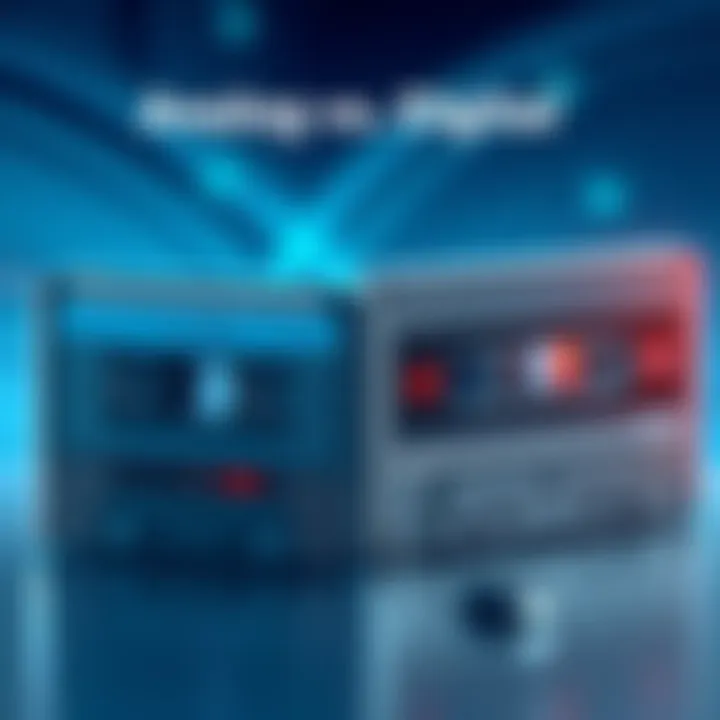
For further reading on cassette players and user reviews, visit Reddit, or check informative articles at Wikipedia.
\
\
\
Design Elements to Consider
When evaluating cassette players equipped with USB connectivity, design elements play a significant role in the overall user experience. From aesthetics to functionality, these components can greatly influence the appeal and usability of the device. Let's face it, style matters just as much as substance, especially in a market that's increasingly saturated with modern digital devices. Thus, understanding these design features is essential for potential buyers, collectors, and audio enthusiasts.
Aesthetic Appeal
The first impression often carries weight, and a cassette player that looks good can draw a crowd even before the music starts. Within the realm of retro music devices, aesthetic considerations are paramount. The blend of vintage charm and modern innovation can create a unique visual footprint. Take a close look at examples like the Sony TCM-150 or Teac W-1200, which seamlessly fuse retro design elements with contemporary finishes.
Some key points to consider:
- Color Schemes: Many modern cassette players come in various colors, appealing to diverse tastes. A vibrant device can lighten the mood and make it a conversation starter in a room.
- Materials Used: The choice of materials impacts not just the look but the feel too. Metal finishes offer durability and elegance, while plastic might seem cheaper but can lighten portable models.
- Trendy Retro Styles: Nostalgia-driven designs can resonate deeply with users, tapping into fond memories of childhood or early music listening experiences.
Design is not merely about visuals; it’s about creating an emotional connection too.
Portability Features
Portability is another crucial aspect when considering a cassette player. The convenience of being able to transport your music easily can either enhance or detract from the experience. Here are some essential portability features worth noting:
- Lightweight Construction: Devices built with lighter materials, such as high-density plastics, ensure that carry-on isn't a cumbersome task.
- Battery Life: A device that boasts a long battery life gives you freedom from being tethered to a power source. Models like the Jensen JTA-230 allow you to enjoy cassette playback on the go without frequent recharges.
- Compact Size: Smaller designs fit easily in bags and cases; this is ideal for music lovers who are always on the move. A player that doesn’t take up much room can make a significant difference.
While portability matters, the balance between size and performance should not be overlooked. It's a question of finding that sweet spot where enjoyment meets practicality.
User Interface and Controls
A user-friendly interface can make or break the experience with any audio device, including cassette players with USB connectivity. Whether technology-savvy or a novice, efficient controls and thoughtfully laid-out interfaces play a crucial role.
Consider the following aspects:
- Intuitive Button Layout: Clear markings and logical placement of buttons can significantly enhance usability, allowing even the least tech-savvy to operate it without a hitch.
- LCD Display: Some models feature a digital display that provides helpful information like track number and battery status. A well-lit, readable screen is a small touch that can significantly enhance user experience.
- Additional Features: Things like a rewind button that's accessible or an easy-to-use USB port can simplify connectivity, making those transitions between analog and digital seamless.
"A well-designed cassette player isn't just an audio device; it's a time capsule that bridges the past with the present." - Audio Enthusiast
For more insights on audio devices and their evolving designs: Wikipedia on Audio Equipment and chatter about music on Reddit.
Connectivity Options
The connectivity options available in cassette players equipped with USB functionality are vital for maximizing the user experience. These options not only redefine how one interacts with music but also bridge the gap between nostalgia and modern convenience. Understanding these connectivity aspects can significantly influence consumer choices, making it critical for anyone looking to dive into the world of cassette players with USB.
Wired Connections
Wired connections form the foundation for solid audio quality in cassette players with USB. Using traditional audio cables can provide a more reliable transmission of sound without the interference that often comes with wireless formats. For example, a simple 3.5mm audio jack leads to an invaluable connection for those who want to connect their cassette player directly to speakers or a home stereo system.
Moreover, some devices come equipped with USB-A or USB-C ports for data transfer. This means you can easily convert old cassette tapes into digital files directly onto your computer. When using a wired connection, users often notice a fuller sound that remains true to the original recording, eliminating any hiccups often seen with wireless transmission.
- Key benefits of wired connections include:
- Consistent audio quality
- Minimal latency
- Direct power source options for extended use
Wireless Technology Integration
In contrast to wired connections, wireless technology brings flexibility and modernity to cassette players with USB. Bluetooth integration, for instance, allows for convenient streaming from various devices like smartphones, tablets, or laptops. Imagine the ease of listening to a favorite tape via a modern sound system—no cords involved.
This wireless aspect isn’t just about convenience. It reflects a shift in how people consume media. The ability to stream also allows for easy sharing among friends or family, as long as they’re within range. Still, it is vital to ensure that your specific cassette player supports the necessary profile for Bluetooth functionality to work properly.
- Benefits of wireless technology include:
- Freedom of movement while listening
- Immediate access to playlists
- Easy setup and use with multiple devices


However, keep in mind that the sound quality might not be as stellar as with a wired connection, often subject to compression depending on the Bluetooth codec used.
Compatibility with Modern Devices
The evolution of cassette players with USB has seen a keen focus on compatibility with today’s gadgets. Many models are designed to seamlessly connect with computers, smartphones, and tablets ensuring that users can easily transfer music files or record their own mixes. This idea of compatibility is not merely about technology; it also speaks to the cultural resurgence of analog formats combining with digital ease.
For instance, some cassette players come with software designed for Windows or macOS, enabling users to edit their recorded content or organize their digital library effectively. Additionally, with the rise of applications that support audio transfers via USB, these cassette players have become more appealing than ever.
- Key compatibility features include:
- Plug-and-play setup with USB ports
- Support for various file types, allowing recordings in multiple formats
- Potential for future updates as technology progresses
In summary, the connectivity options in cassette players with USB connectivity not only enhance the overall experience but also ensure that these devices remain relevant in today's pop culture landscape. Whether you’re inclined towards the reliability of wired connections, the convenience of wireless technology, or the compatibility with modern devices, the choices available cater to a broad range of preferences and needs. Consideration of these factors can greatly inform your purchasing decisions in an increasingly digital world.
Market Trends and Consumer Interest
The resurgence of cassette players equipped with USB connectivity reflects a notable trend in the audio market. This trend signifies a complex tapestry of cultural nostalgia intertwined with modern technological advancements. As consumers seek out unique audio experiences, the marriage of retro and modern functions captures a wide audience and sparks renewed interest.
The Return of Retro Products
In recent years, there has been a palpable shift towards retro products across various industries. For many, cassette players aren’t just about playback; they evoke memories of a bygone era. The physicality of inserting a cassette and the tactile experience of rewinding tapes is a world apart from today’s digital immediacy. The USB feature caters to a new generation as well, allowing users to convert these analog treasures into digital formats seamlessly.
This return to retro is not merely a fad but rather an expression of authenticity. Vintage vibes resonate with younger audiences who crave uniqueness amid a market saturated with uniformity. Consumers are not just buying cassette players; they are purchasing a slice of history—one that they wish to share with friends on social media platforms. Coupled with modern technology, these devices manage to cater both to nostalgia lovers and tech-savvy individuals.
Demographics of Users
When exploring who is drawn to these quirky devices, it becomes clear that the consumer base is not monolithic. The demographic breakdown is quite fascinating:
- Baby Boomers: Those who grew up with cassette culture are a significant segment. They often seek to relive fond memories of mixtapes and car rides filled with their favorite songs.
- Millennials and Gen Z: Surprisingly, younger generations are diving in too. As they lean towards vintage trends, they appreciate the novelty of cassettes while enjoying the benefits of USB connectivity for easier use and portability.
- Audiophiles: There’s a niche group of audio enthusiasts who are drawn to the unique sound characteristics of cassette tapes. They enjoy the warm, analog sound and also appreciate the ability to digitize their collections.
Understanding this diverse user base informs manufacturers and marketers alike. It helps shape product features and advertising strategies, ensuring that offerings resonate across age groups and preferences.
Impact on Audio Collectibles Market
The revival of cassette players with USB connectivity has stirred significant activity within the audio collectibles market. This push toward revival isn’t just about nostalgia—there’s a strong financial component called “collectibility” involved. Unique, limited-edition cassette releases often become hot commodities among collectors, driving prices higher.
As individuals seek to own pieces of music history, cassette tapes have gained a kind of cult status. Here are several ways this phenomenon unfolds:
- Limited Editions: Record labels frequently release special edition mixtapes or albums in cassette format. Limited runs typically draw substantial interest from collectors.
- Community Engagement: Platforms like Reddit and Facebook groups dedicated to cassette collecting are thriving, providing spaces for enthusiasts to connect, share finds, and trade cassettes.
- Price Fluctuations: Collectible cassettes can vary in value, with rare editions fetching impressive sums. This trend is monitored carefully by collectors and can augment the interest in USB-enabled players that allow for the preservation of these collectibles.
*"Cassette tapes are not just relics from the past; they are assets in a collector's portfolio, intertwining nostalgia with a smart investment choice."*
Closure and Future Outlook
In wrapping up our exploration of cassette players with USB connectivity, it is crucial to recognize the multifaceted role these audio devices play in today’s tech-savvy world. The union of nostalgic charm and contemporary functionality offers a unique pathway for both old-school enthusiasts and new users alike.
Summarizing Key Findings
To distill the essence of what we've discussed, it can be observed that cassette players with USB capabilities present several notable features:
- Nostalgia: Many individuals find themselves drawn to the warm sound and tactile experience of analog music, which stands in contrast to the impersonal nature of digital streaming. The familiarity of tapes taps into cherished memories, providing not just music but an experience.
- Modern Functionality: These devices allow users to record from digital sources, effectively bridging the gap between past and present audio formats. The ease of converting cassettes to digital files offers a clear benefit for those looking to preserve their audio history.
- Versatile Playback: With the capability to play various digital files, these cassette players stand ready to accommodate a multitude of needs. Whether it’s a cherished mix or a newly created playlist, possibilities abound.
- User-Friendly Design: Many of these players come with straightforward controls and aesthetic choices that cater to modern tastes while ensuring accessibility for all users.
It’s evident that cassette players with USB connectivity are not merely retro curiosities but rather multifunctional devices meeting contemporary audio demands.
Predictions for Next-Gen Devices
Looking ahead, we can expect several exciting advancements in cassette player technology:
- Enhanced Connectivity: Future models may explore greater integration with smart devices, allowing for features such as app control functionality or wireless output to Bluetooth speakers. Pairing with mobile devices might lead to seamless accessibility to both old and new tracks.
- Improved Audio Quality: With technological advancements, we may see significant developments in the fidelity of playback, enhancing the experience for audiophiles and casual listeners alike. Upgraded components could lead to both clearer sound and longer lifespans for devices.
- Sustainability: As the world shifts toward more eco-conscious practices, manufacturers might begin to innovate with materials and methods that reduce environmental impact while still delivering quality.
- Customization Options: Having the option to personalize designs or features would create a stronger connection for users, making the devices more engaging.
In essence, the future of cassette players with USB integration is not set in stone. As the integration of retro technology with evolving needs continues, these devices will likely take on increasingly critical roles in personal and collective audio experiences. For tech enthusiasts, casual consumers, and audio collectibles lovers, the continued evolution presents an opportunity for exploration and enjoyment that is as enriching as it is nostalgic.
"Music can change the world because it can change people." - Bono
To learn more about the resurgence of cassette players and their impact on modern audio culture, check out resources like Wikipedia or forums on Reddit.



